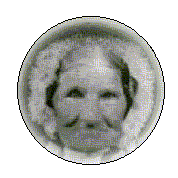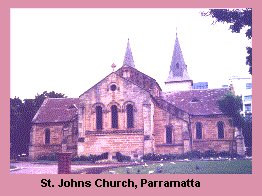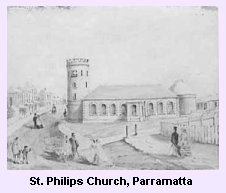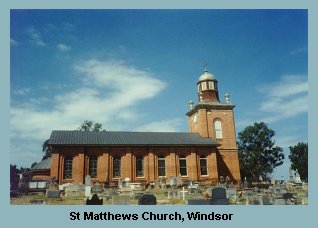|
JOHN GRAY was transported on the convict ship "Barwell" in 1798. He was sentenced in 1793 for receiving stolen goods and sentenced to death, later commuted and sent to Australia for life.
ELIZABETH KILLETT was transported on the ship "Nile" in 1801. She was sentenced for stealing on the 31st July 1800 and was sent to Australia for 7 years. The ship "Nile" arrived in Australia on 14th December 1801. John died by drowning on the 4th day of September 1818 aged 56 years.

John Gray and Elizabeth Killett were married at St. Johns Parramatta by the Rev. Samuel Marsden on the 26th July, 1803. V1803544 3A/1803 Witnesses were John Marshall and Eleanor Carty. Their first child Elizabeth was Baptised by Rev. Marsden on the same day. Elizabeth died on the 22nd day of October 1875. They had 7 children:-
07/05/1803 Elizabeth Gray. Baptised by Rev. Marsden 26/07/1803 at St. Johns Parramatta. V18031176 1A/1803. Henry S.
Townsend
24/06/1805 William Gray. Born "at Hawksbury" and baptised 11/08/1805 at St. Johns Parramatta. V18051470 1A/1805. Mary Wheeler
1808 -1880 Jane Gray. Alexander Sinclair Manson
16/06/1810 John Gray (Junior). V18102398 1A/1810. Baptised 05/04/1811 at St. Matthews Windsor.
19/11/1813 Hannah Gray. Baptised 21/06/1818 at St. Philips Sydney. William Jones
19/01/1815 Ann Louise Gray. V18154481 1B/1815. Baptised 21/06/1818 at St. Philips Sydney. Hayward Atkins
06/11/1817 Richard Gray. V18174482 1B/1817. Baptised 21/06/1818 at St. Philips Sydney. Mary Ann Gold


In January 1788 eleven ships and their companies, under the command of Captain Arthur Phillip RN, and carrying 759 people arrived on the east coast of what is now Australia to establish a penal colony. The Chaplain of this, the First Fleet, was the Rev Richard Johnson and he conducted the first Christian service in Australia on 3 February 1788.
Sydney's first Church.
A T-shaped building at what is now the corner of Bligh and Hunter streets, made of wattle and daub with a thatched roof and an earthen floor, it could seat 500. During the week it served as a schoolhouse where the Reverend Richard Johnson, the colonial chaplain, and his wife, Mary, taught between 150 and 200 children. It was in this building that Australia's first Christian service in a building took place on 25th August 1793.
Chaplain Johnson took the Word to the aboriginal people and the convict population held him in deep affection. Yet on the evening of 1st October 1798 this chapel was burnt down.
Later that month the Governor, John Hunter, initiated work on what he saw to be a substantial stone church. It was to rise on land at Church Hill in what is now Lang Park. Just across the road from the present church. The new stone church named St Philip's was opened in 1810, and this was replaced by the current building in 1856. Captain Philip's second in command, and the third Governor of New South Wales, Phillip Gidley King had proclaimed the Parish in 1802.
On 1st October 1800, prior to his being sworn in as the new Governor, Captain Philip Gidley King laid the foundation stone on what was to become the first St Philip's. In 1802 he proclaimed Australia's first two parishes as St Philip's (Sydney) and St John's (Parramatta).
'Old' St Philip's served Sydney from this date until 27th March 1856 when the present church was consecrated.
Settlement of the Hawkesbury by Europeans first occurred in January 1794 when twenty two families were granted farms on Pitt Town Bottoms, then known as Bardenarang. The Hawkesbury was originally settled in the late 18th century as a source of food for the struggling colony of New South Wales. The first settlement at what is now known as Windsor was called Green Hills and existed under this name until Governor Lachlan Macquarie renamed it Windsor on the 6th December 1810. On this day he also named the four other "Macquarie Towns" of Castlereagh, Richmond, Pitt Town and Wilberforce.
St Matthew's was actually the fourth building to be used as a church in Windsor between 1803 and 1817. Prior to the arrival of Governor Macquarie there was very little government assistance for public buildings and the London Missionary Society provided the money for the first church.
In a Government and General Order issued from Government House, Sydney, dated 15 December, 1810, Governor Macquarie "marked out the district of Green Hills", which he "... called Windsor" after Windsor on the Thames in the United Kingdom. Whilst in Windsor, Macquarie ordered the outward signs of settlement to be erected, such as a church, a school-house, a gaol and a "commodious inn". Of these the most imposing was Greenway's St Matthew's Anglican Church for which Macquarie chose the site.
The first building begun on the site of St Matthew's was to be a two-storey building constructed by Henry Kitchen to a design by Francis Greenway who is acknowledged as the architect, but whose name does not appear on the original plan. On Saturday, 11 October, 1817 Macquarie deposited the rim of a Spanish dollar worth 6/- under the sandstone cornerstone of the building declaring "God prosper St Matthew's Church". This was stolen later that night so the next evening Governor Macquarie deposited another coin and re-laid the cornerstone. The same thing happened again and it was supposed that the money was stolen by an "indigent convict" employed at the Public Works.
Work on the new church proceeded very slowly and eventually Macquarie sent architect Greenway to investigate. Greenway found the work of inferior quality and the bricks below standard. Of what we now know of Greenway this could have all been sour grapes as he was not involved in the original construction. The building was razed to the ground. The rejected bricks were used to build a wall next to the Macquarie Arms hotel in Windsor and are still there, even surviving the big flood of 1867, so one wonders about their inferiority as stated by Greenway.
Greenway designed a totally new structure and directed the building of the new church himself, overseeing the stonemasons and construction workers. He was a master craftsman and the building was completed with speed and skill. The building was sufficiently advanced to be available for church services in September, 1821 and was consecrated the next year by the Reverend Samuel Marsden, the Principal Chaplain of the Colony.
Francis Greenway, whose sentence of death was later commuted to 14 years transportation as a result of forgery, arrived in the colony two years after Macquarie. As an individual Greenway was an extremely difficult personality, making many enemies throughout his life. However as an architect and builder he was knowledgeable, thorough and imaginative. Greenway brought with him a letter of introduction from a previous Governor of the colony, Hunter. Although Macquarie was rather hesitant of employing the conceited Greenway, whom Freeland describes as coming from the "penal scrap heap", he realised that with very little to choose from, this architect was the best of the bunch. Greenway soon proved his ability by designing and erecting some sensitive and beautiful buildings such as the Court House at Windsor and St James' Church in Sydney. For these achievements Greenway received a free pardon.
Greenway, who Max Dupain acknowledges as a genius, died a pauper and is buried in a forgotten grave in East Maitland. However he left behind a magnificent architectural heritage. St Matthew's remains virtually untouched and a beautiful landmark set on an eminence overlooking the Hawkesbury River and the Blue Mountains.

Designed by Francis Greenway, the church is the second oldest in Australia. The foundation stone was laid by Governor Lachlan Macquarie on 11 October 1817. The first services were held in September 1821.
St Matthew's church was sufficiently rebuilt under Greenway to be used for a service in September 1821 but was not consecrated until 18 December 1822.
The Rev. Samuel Marsden, principal Chaplain of the Colony, consecrated the Church on the 18th December 1822 and the Hawkesbury settlers attended the service in large numbers.
A fine Georgian Church, constructed entirely by convict labour using sandstock bricks and sandstone. The dominant element is a sculptural square tower with octagonal cupola, axially arranged with a rectangular nave and semi circular apse. The interior contains much fine cedar joinery, including a coffered ceiling and gallery. Its siting is magnificent, on a hill above the town, and this reveals Greenway's sensitive appreciation of a building's relationship to the landscape.

The Early Years ¦
Elizabeth Gray 1803 - 1836 ¦
William Gray 1805 - 1851 ¦
Jane Gray 1808 - 1880
John Gray Jr. 1810 ¦
Hannah Gray 1813 - 1856 ¦
Ann Louise Gray 1815 - 1874
Richard Gray 1817 - 1896
The Killett Family ¦ Newspaper clippings (New)
THE SECOND AUSTRALIAN GENERATION
Rebecca Gray ¦ Elizabeth A. Gray ¦ Hannah Gray ¦
William John Best Gray ¦ Mary Gray
THE THIRD AUSTRALIAN GENERATION
William R. Gray ¦ Emily J. Gray ¦ Eliza A. Gray ¦ Mary E. Gray ¦ Henry Best Gray ¦ George C. Gray
Wallace J. Gray ¦ Edward Gray ¦ Joseph F. Gray ¦ Annie A. Gray ¦
Arthur Lytton Gray
THE FOURTH AUSTRALIAN GENERATION
Noel Francis Gray ¦
Eric Gray ¦
Francis Gordon Gray ¦
Athol C. Gray
THE FIFTH AUSTRALIAN GENERATION
Athol Wayne Gray ¦ Jennifer L. Gray ¦ Kerry Lytton Gray ¦ Eric G. Gray ¦ Gordon W. Gray
Alan J. Gray ¦ Neal J. Gray ¦ Ian Gray
THE SIXTH AUSTRALIAN GENERATION
Brendon John Gray ¦ Allyson Joy Gray ¦ Rohan Paul Gray ¦ Guy B. Phillips ¦ Melinda Phillips
Susannah Phillips ¦ Shannon Gray ¦ Dylan J. Gray ¦ Rachael Lee Gray ¦ Elisha M. Gray ¦ Tehia L. Gray
Jason M. Gray
THE SEVENTH AUSTRALIAN GENERATION
Dylan James Gray ¦ Ethan Kane Gray ¦ Riely Paul Gray ¦ Patrick B. Phillips ¦ Madaline Phillips
Letters from Elizabeth Killett Gray ¦
Trials ¦ Trips & Ships
Letters from William J.B. Gray ¦ Crest & Tartan ¦ Special Acknowledgements

Back to Index

Email Author
|
|







